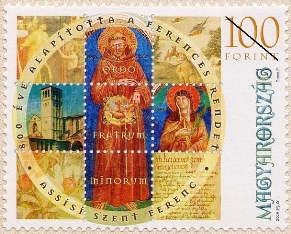ST FRANCIS OF ASSISI FOUNDED THE FRANCISCAN ORDER 800 YEARS AGO
Date of issue: 24 February 2009

St Francis of Assisi (26 September 1181 or 1182 – 3 October 1226)
is the founder of the Franciscan Order and the patron saint of Italy,
animals, merchants and the environment.
After a pilgrimage to Rome
he had a mystical experience at the church of San Damiano near Assisi.
An icon of Christ crucified spoke to him saying, “Francis, Francis, go
and repair my house, which, as you can see, is falling into ruins”. He
sold his horse and some cloth from his father’s store and donated the
proceeds to repair the church. Francis renounced his father and his
patrimony, and for the next few months lived as a beggar around Assisi.
On
24 February 1209, on hearing Matthew 10:9 he decided to live a life of
apostolic poverty. In a rough garment and barefoot, he began to preach
repentance. Soon he attracted followers. Out of humility he chose not to
be ordained but lived in a community calling themselves “lesser
brothers” or frates minores in Latin. In 1209 Pope Innocent III granted
permission for him to establish a new order to live the apostolic life
Christ taught the apostles. Its members took a vow of poverty and
devoted their lives to serving God.
On 17 September 1223 Francis
received the stigmata while praying, but this was only revealed after
his death. He was made a saint by Pope Gregory IX on 16 July 1228 and
the next day the foundation stone of the Basilica of St Francis in
Assisi was laid. (Source:
http://hu.wikipedia.org/wiki/Assisi_Szent_Ferenc)The perforation in the form of a cross divides the stamp into 5
main and 4 side fields with the Franciscan arms in the centre. The main
motif of the stamp design is the figure of Saint Francis surrounded by a
few of the major events from his life and places associated with him.
These include Saint Francis renouncing his worldly goods, the Basilica
of Saint Francis, Saint Francis receiving the stigmata, the figure of
Saint Clare, and extracts of prayers and contemplation. The graphic
composition on the first day cover features other elements associated
with the founder of the Order, one of which has a Hungarian association.
Pelbart of Temesvár is the most well-known figure in Hungarian
scholasticism. The commemorative postmark is a stylized design of Christ
on the cross.Order number: 2009010010011 (stamp) / 2009010060012 (FDC)
Date of issue: 24 February 2009
Printed by Pénzjegynyomda
Designed by Eszter Domé
Printing method: offset
Perforated size of stamp: 50 x 40 mm (40 stamps/sheet)
Number of copies: 250,000
More information: philately@posta.hu

